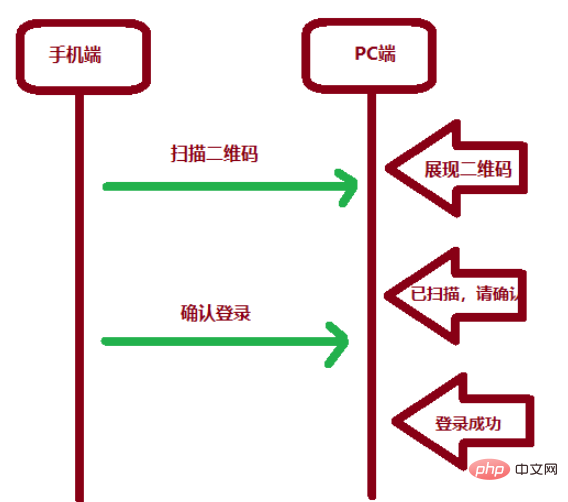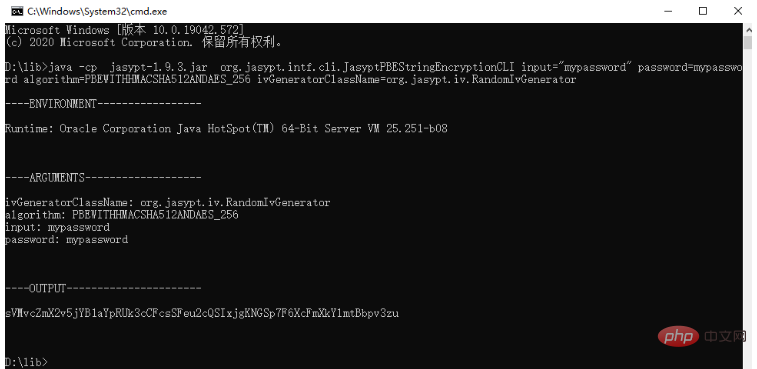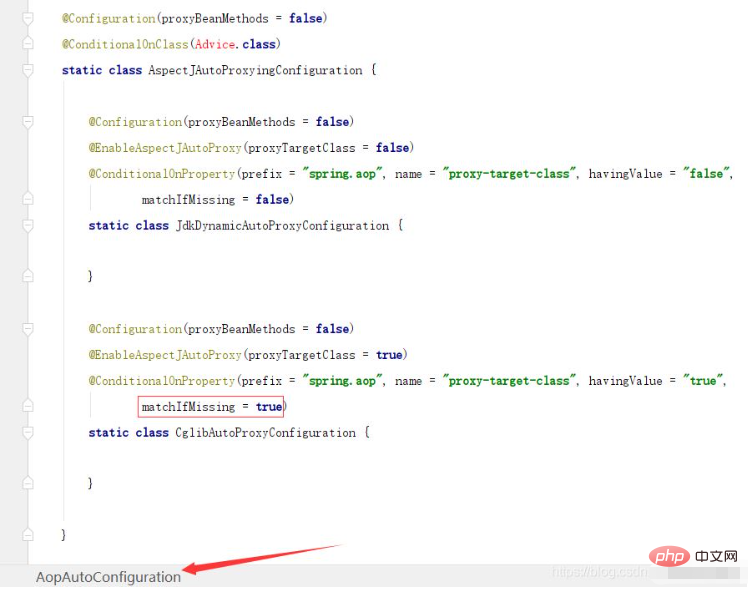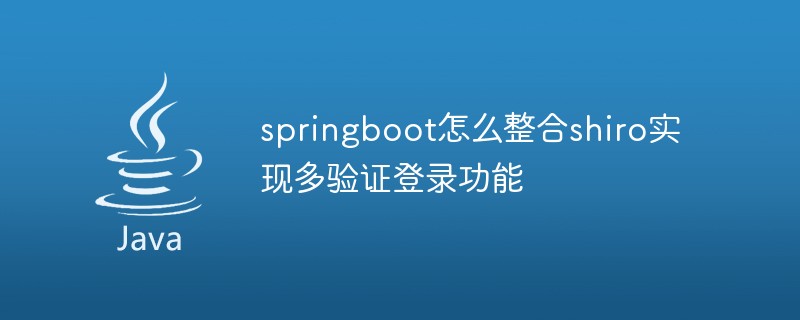1. Specific implementation steps
Add an interceptor, set UUID as a unique identifier, and store it in the database
Query through the account of the current login
If the current If the UUID value stored in the user's session is the same as the UUID value in our database, pass
Otherwise, return false, indicating that the user has logged in on another device or browser
2. Code display
First we create a new Spring project
Add the following dependencies

yml configuration file
server:
port: 8080
spring:
datasource:
driver-class-name: com.mysql.cj.jdbc.Driver
url: jdbc:mysql://127.0.0.1:3306 /userdb?characterEncoding=utf-8&&severTimezone=utc
username: root
password: root
thymeleaf:
mode: HTML5
cache: false
suffix: .html
prefix : classpath:/templates/
mybatis:
Mapper-locations: classpath:/mapper/*.xml #Introduce mapper files
type-aliases-package: com.bdqn.springsso.pojo #Introduce type aliases
pom.xml configuration file
<?xml version="1.0" encoding="UTF-8"?>
<project xmlns="http://maven.apache.org/POM/4.0.0" xmlns:xsi="http://www.w3.org/2001/XMLSchema-instance"
xsi:schemaLocation="http://maven.apache.org/POM/4.0.0 https://maven.apache.org/xsd/maven-4.0.0.xsd">
<modelVersion>4.0.0</modelVersion>
<parent>
<groupId>org.springframework.boot</groupId>
<artifactId>spring-boot-starter-parent</artifactId>
<version>2.7.5</version>
<relativePath/> <!-- lookup parent from repository -->
</parent>
<groupId>com.bdqn</groupId>
<artifactId>springsso</artifactId>
<version>0.0.1-SNAPSHOT</version>
<name>springsso</name>
<description>Demo project for Spring Boot</description>
<properties>
<java.version>1.8</java.version>
</properties>
<dependencies>
<dependency>
<groupId>org.springframework.boot</groupId>
<artifactId>spring-boot-starter-thymeleaf</artifactId>
</dependency>
<dependency>
<groupId>org.springframework.boot</groupId>
<artifactId>spring-boot-starter-web</artifactId>
</dependency>
<dependency>
<groupId>org.mybatis.spring.boot</groupId>
<artifactId>mybatis-spring-boot-starter</artifactId>
<version>2.2.2</version>
</dependency>
<dependency>
<groupId>com.mysql</groupId>
<artifactId>mysql-connector-j</artifactId>
<scope>runtime</scope>
</dependency>
<dependency>
<groupId>org.projectlombok</groupId>
<artifactId>lombok</artifactId>
<optional>true</optional>
</dependency>
<dependency>
<groupId>org.springframework.boot</groupId>
<artifactId>spring-boot-starter-test</artifactId>
<scope>test</scope>
</dependency>
</dependencies>
<build>
<plugins>
<plugin>
<groupId>org.springframework.boot</groupId>
<artifactId>spring-boot-maven-plugin</artifactId>
<configuration>
<excludes>
<exclude>
<groupId>org.projectlombok</groupId>
<artifactId>lombok</artifactId>
</exclude>
</excludes>
</configuration>
</plugin>
</plugins>
</build>
</project>Backend code
Create the following packages in the java directory, and create the mapper package in resources

First write the pojo layer entity class User
Note: When creating a table in MySQL, the data type of uuid is varchar, and the length must be larger, otherwise it will run Report an error
package com.bdqn.springsso.pojo;
import lombok.Data;
@Data
public class User {
//用户id
private Integer id;
//账户
private String username;
//密码
private String password;
//uuid
private String uuid;
}Then write the mapper layer UserMapper interface
package com.bdqn.springsso.mapper;
import com.bdqn.springsso.pojo.User;
import org.apache.ibatis.annotations.Mapper;
import org.apache.ibatis.annotations.Param;
@Mapper
public interface UserMapper {
//根据姓名和密码查询
User chekLogin(@Param("username") String username, @Param("password") String password);
//根据姓名修改uuid
void update(@Param("uuid") String uuid,@Param("username") String username);
//根据姓名查询uuid
String getUUID(@Param("username") String username);
}Then write the service layer UserService and UserServiceImpl
package com.bdqn.springsso.service;
import com.bdqn.springsso.pojo.User;
public interface UserService {
//根据姓名和密码查询
User chekLogin(String username, String password);
//根据姓名修改uuid
void update(String uuid,String username);
}package com.bdqn.springsso.service;
import com.bdqn.springsso.mapper.UserMapper;
import com.bdqn.springsso.pojo.User;
import org.springframework.beans.factory.annotation.Autowired;
import org.springframework.stereotype.Service;
@Service
public class UserServiceImpl implements UserService {
@Autowired
private UserMapper userMapper;
@Override
public User chekLogin(String username, String password) {
return userMapper.chekLogin(username,password);
}
@Override
public void update(String uuid,String username) {
userMapper.update(uuid,username);
}
}Then write the interceptor layer UserInterceptor interceptor
package com.bdqn.springsso.interceptor;
import com.bdqn.springsso.mapper.UserMapper;
import org.springframework.web.servlet.HandlerInterceptor;
import javax.servlet.http.HttpServletRequest;
import javax.servlet.http.HttpServletResponse;
import javax.servlet.http.HttpSession;
public class UserInterceptor implements HandlerInterceptor {
private UserMapper userMapper;
public UserInterceptor(UserMapper userMapper){
this.userMapper=userMapper;
}
@Override
public boolean preHandle(HttpServletRequest request, HttpServletResponse response, Object handler) throws Exception {
HttpSession session = request.getSession();
String username = (String) session.getAttribute("username");
//数据库
String UUID=userMapper.getUUID(username);
//session
String uuid = (String)session.getAttribute("uuid");
System.out.println("uuid = " + uuid);
System.out.println("UUID = " + UUID);
if(UUID.equals(uuid)){
return true;
}else {
System.out.println("拦截"+request.getRequestURI());
response.sendRedirect("/login");
response.setStatus(401);
return false;
}
}
}Then the controller layer UserController
package com.bdqn.springsso.controller;
import com.bdqn.springsso.pojo.User;
import com.bdqn.springsso.service.UserService;
import org.springframework.beans.factory.annotation.Autowired;
import org.springframework.stereotype.Controller;
import org.springframework.web.bind.annotation.CrossOrigin;
import org.springframework.web.bind.annotation.RequestMapping;
import org.springframework.web.bind.annotation.ResponseBody;
import javax.servlet.http.HttpSession;
import java.util.UUID;
@Controller
@CrossOrigin
public class UserController {
@Autowired
private UserService userService;
//登录
@RequestMapping("/")
public String goLogin(){
return "login";
}
//登录验证
@RequestMapping("/login")
public String chekLogin(String username, String password, HttpSession session){
User user=userService.chekLogin(username,password);
if (user==null){
return "login";
}else {
session.setAttribute("username",username);
String uuid= UUID.randomUUID().toString().replace("-", "");
System.out.println("uuid = " + uuid);
userService.update(uuid,username);
session.setAttribute("uuid",uuid);
return "index";
}
}
//测试
@RequestMapping("/test")
@ResponseBody
public String test(){
return "成功";
}
}Then the writing of the config layer MvcConfig
package com.bdqn.springsso.config;
import com.bdqn.springsso.interceptor.UserInterceptor;
import com.bdqn.springsso.mapper.UserMapper;
import org.springframework.beans.factory.annotation.Autowired;
import org.springframework.context.annotation.Configuration;
import org.springframework.web.servlet.config.annotation.InterceptorRegistry;
import org.springframework.web.servlet.config.annotation.WebMvcConfigurer;
@Configuration
public class MvcConfig implements WebMvcConfigurer {
@Autowired
private UserMapper userMapper;
@Override
public void addInterceptors(InterceptorRegistry registry) {
//添加拦截器,排除/路径和 /login路径
registry.addInterceptor(new UserInterceptor(userMapper))
.excludePathPatterns("/","/login");
}
}The last is the writing of userMapper.xml
<?xml version="1.0" encoding="UTF-8" ?>
<!DOCTYPE mapper
PUBLIC "-//mybatis.org//DTD Mapper 3.0//EN"
"http://mybatis.org/dtd/mybatis-3-mapper.dtd">
<mapper namespace="com.bdqn.springsso.mapper.UserMapper">
<update id="update">
update user set uuid=#{uuid} where username=#{username}
</update>
<select id="chekLogin" resultType="com.bdqn.springsso.pojo.User">
select * from user where username=#{username} and password=#{password}
</select>
<select id="getUUID" resultType="java.lang.String">
select uuid from user where username=#{username}
</select>
</mapper>The front-end code
login.html
<!DOCTYPE html>
<html lang="en" xmlns:th="http://www.thymeleaf.org">
<head>
<meta charset="UTF-8">
<title>Login Module</title>
</head>
<body>
<h2 id="欢迎来到登录页面">欢迎来到登录页面</h2>
<form th:action="@{/login}" method="post">
用户:<input type="text" name="username"><br>
密码:<input type="password" name="password"><br>
<button type="submit">登录</button>
</form>
</body>
</html>index.html
<!DOCTYPE html>
<html lang="en" xmlns:th="http://www.thymeleaf.org">
<head>
<meta charset="UTF-8">
<title>Title</title>
</head>
<body>
<h2 id="登录成功">登录成功</h2>
<a th:href="@{/test}" rel="external nofollow" >测试</a>
</body>
</html>Effect display
First we use Firefox browser to operate
Enter http:// localhost:8080/Enter the login page






The above is the detailed content of How to implement SpringBoot single sign-on. For more information, please follow other related articles on the PHP Chinese website!
 怎么使用SpringBoot+Canal实现数据库实时监控May 10, 2023 pm 06:25 PM
怎么使用SpringBoot+Canal实现数据库实时监控May 10, 2023 pm 06:25 PMCanal工作原理Canal模拟MySQLslave的交互协议,伪装自己为MySQLslave,向MySQLmaster发送dump协议MySQLmaster收到dump请求,开始推送binarylog给slave(也就是Canal)Canal解析binarylog对象(原始为byte流)MySQL打开binlog模式在MySQL配置文件my.cnf设置如下信息:[mysqld]#打开binloglog-bin=mysql-bin#选择ROW(行)模式binlog-format=ROW#配置My
 Spring Boot怎么使用SSE方式向前端推送数据May 10, 2023 pm 05:31 PM
Spring Boot怎么使用SSE方式向前端推送数据May 10, 2023 pm 05:31 PM前言SSE简单的来说就是服务器主动向前端推送数据的一种技术,它是单向的,也就是说前端是不能向服务器发送数据的。SSE适用于消息推送,监控等只需要服务器推送数据的场景中,下面是使用SpringBoot来实现一个简单的模拟向前端推动进度数据,前端页面接受后展示进度条。服务端在SpringBoot中使用时需要注意,最好使用SpringWeb提供的SseEmitter这个类来进行操作,我在刚开始时使用网上说的将Content-Type设置为text-stream这种方式发现每次前端每次都会重新创建接。最
 SpringBoot怎么实现二维码扫码登录May 10, 2023 pm 08:25 PM
SpringBoot怎么实现二维码扫码登录May 10, 2023 pm 08:25 PM一、手机扫二维码登录的原理二维码扫码登录是一种基于OAuth3.0协议的授权登录方式。在这种方式下,应用程序不需要获取用户的用户名和密码,只需要获取用户的授权即可。二维码扫码登录主要有以下几个步骤:应用程序生成一个二维码,并将该二维码展示给用户。用户使用扫码工具扫描该二维码,并在授权页面中授权。用户授权后,应用程序会获取一个授权码。应用程序使用该授权码向授权服务器请求访问令牌。授权服务器返回一个访问令牌给应用程序。应用程序使用该访问令牌访问资源服务器。通过以上步骤,二维码扫码登录可以实现用户的快
 spring boot怎么对敏感信息进行加解密May 10, 2023 pm 02:46 PM
spring boot怎么对敏感信息进行加解密May 10, 2023 pm 02:46 PM我们使用jasypt最新版本对敏感信息进行加解密。1.在项目pom文件中加入如下依赖:com.github.ulisesbocchiojasypt-spring-boot-starter3.0.32.创建加解密公用类:packagecom.myproject.common.utils;importorg.jasypt.encryption.pbe.PooledPBEStringEncryptor;importorg.jasypt.encryption.pbe.config.SimpleStrin
 SpringBoot/Spring AOP默认动态代理方式是什么May 10, 2023 pm 03:52 PM
SpringBoot/Spring AOP默认动态代理方式是什么May 10, 2023 pm 03:52 PM1.springboot2.x及以上版本在SpringBoot2.xAOP中会默认使用Cglib来实现,但是Spring5中默认还是使用jdk动态代理。SpringAOP默认使用JDK动态代理,如果对象没有实现接口,则使用CGLIB代理。当然,也可以强制使用CGLIB代理。在SpringBoot中,通过AopAutoConfiguration来自动装配AOP.2.Springboot1.xSpringboot1.xAOP默认还是使用JDK动态代理的3.SpringBoot2.x为何默认使用Cgl
 使用Java SpringBoot集成POI实现Word文档导出Apr 21, 2023 pm 12:19 PM
使用Java SpringBoot集成POI实现Word文档导出Apr 21, 2023 pm 12:19 PM知识准备需要理解ApachePOI遵循的标准(OfficeOpenXML(OOXML)标准和微软的OLE2复合文档格式(OLE2)),这将对应着API的依赖包。什么是POIApachePOI是用Java编写的免费开源的跨平台的JavaAPI,ApachePOI提供API给Java程序对MicrosoftOffice格式档案读和写的功能。POI为“PoorObfuscationImplementation”的首字母缩写,意为“简洁版的模糊实现”。ApachePOI是创建和维护操作各种符合Offic
 springboot怎么整合shiro实现多验证登录功能May 10, 2023 pm 04:19 PM
springboot怎么整合shiro实现多验证登录功能May 10, 2023 pm 04:19 PM1.首先新建一个shiroConfigshiro的配置类,代码如下:@ConfigurationpublicclassSpringShiroConfig{/***@paramrealms这儿使用接口集合是为了实现多验证登录时使用的*@return*/@BeanpublicSecurityManagersecurityManager(Collectionrealms){DefaultWebSecurityManagersManager=newDefaultWebSecurityManager();
 Springboot如何实现视频上传及压缩功能May 10, 2023 pm 05:16 PM
Springboot如何实现视频上传及压缩功能May 10, 2023 pm 05:16 PM一、定义视频上传请求接口publicAjaxResultvideoUploadFile(MultipartFilefile){try{if(null==file||file.isEmpty()){returnAjaxResult.error("文件为空");}StringossFilePrefix=StringUtils.genUUID();StringfileName=ossFilePrefix+"-"+file.getOriginalFilename(


Hot AI Tools

Undresser.AI Undress
AI-powered app for creating realistic nude photos

AI Clothes Remover
Online AI tool for removing clothes from photos.

Undress AI Tool
Undress images for free

Clothoff.io
AI clothes remover

AI Hentai Generator
Generate AI Hentai for free.

Hot Article

Hot Tools

SublimeText3 Linux new version
SublimeText3 Linux latest version

EditPlus Chinese cracked version
Small size, syntax highlighting, does not support code prompt function

SublimeText3 Chinese version
Chinese version, very easy to use

Notepad++7.3.1
Easy-to-use and free code editor

Dreamweaver Mac version
Visual web development tools







